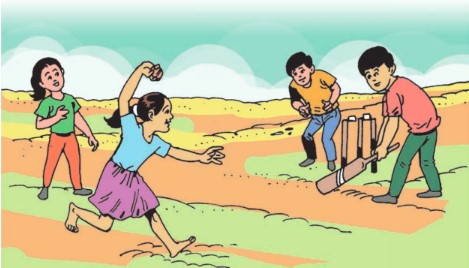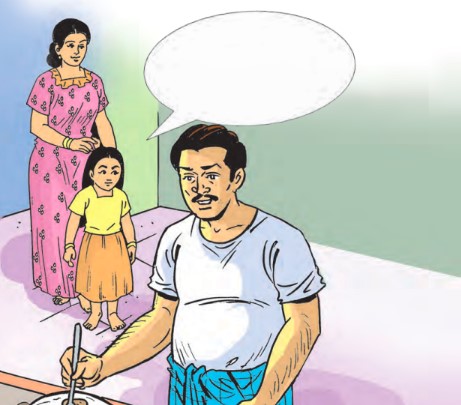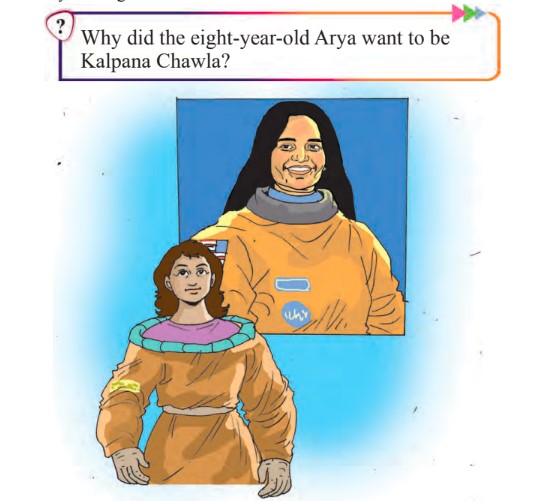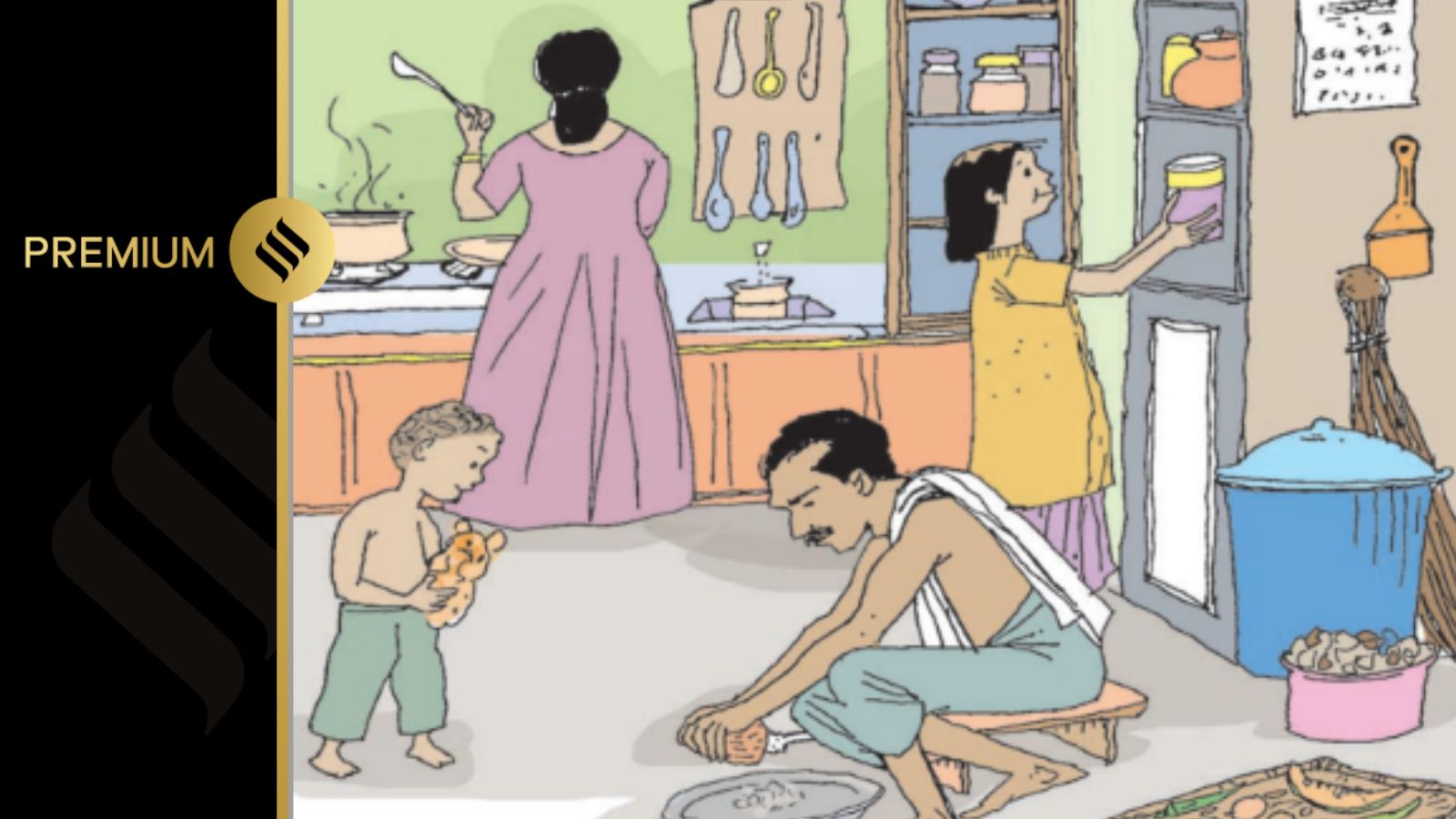A man grates a coconut in the kitchen while his wife cooks a meal. Their daughter helps by putting a can back in its place on the kitchen cabinet, and the son plays with a soft toy. This scene, though it may seem unconventional in a traditionally patriarchal society, is from the newly introduced Malayalam textbook for Class 3. Captioned ‘Veetile pradhana thozhilidamaanu adukkala’ (‘The kitchen is the main workplace in a house’), it conveys that it is normal for boys to play with soft toys and for men to work in the kitchen.
It is one among the many changes introduced by the Kerala government in the textbooks for Classes 1, 3, 5, 7, and 9, as it aims to shatter patriarchal gender norms.
As opposed to the usual illustrations in Indian school textbooks showing men reading newspapers, with a cup of tea by their side, and women working in the kitchen, the revised textbooks subtly drill down the idea in young minds that every member of the household, regardless of gender, has a part to play in the daily chores.
Talking about the revisions, Dr Sreerekha Sathi, professor of gender and political economy at the Erasmus University in the Netherlands, says, “It is a great step. Textbooks are foundational for the young generation, influencing their thoughts and shaping their minds. Even in 2024, there are many who are progressive in public spaces but follow the same patriarchal approach at home, believing all household chores are the responsibility of women.”
Breaking gender stereotypes
For ages now, textbooks in Indian schools and colleges have depicted patriarchal and regressive ideas. Take for example, 2017 sociology textbook for Class 12 in Maharashtra, which shows dowry as an “incentive” for the groom’s side to accept an “ugly” or “handicapped” woman, or a Hindi language textbook for Class 9, published by the Rajasthan Education Board, equating housewives to donkeys that men “own”. Then there have been textbooks labelling fair-skinned people as “beautiful” and dark-skinned as “ugly” –– like a book for nursery students shared by an IAS officer on X.
With the portrayal of reimagined gender roles, the schools in Kerala are breaking stereotypes.

One of the questions in the illustration in the Malayalam textbook cited above urges kids to recollect the scene at their homes and share the tasks they noticed in the kitchen. Another illustration shows both girls and boys playing cricket together.

Not only Malayalam, such images also adorn the pages of other textbooks.
The English language textbook for Class 3 follows the journey of a kid named Sasha. The image depicts Sasha walking into the kitchen in the morning, after being woken up by her mother, where her father can be seen preparing a snack.
Another illustration shows Shasha’s father making tea, as she washes dishes and her mother cleans a fan.
Next to the illustration are questions that intend to initiate a discussion on labour, both paid and unpaid, and conventional gender roles.


“Women now are encouraged to pursue careers, that is, to do paid work like men, but are also expected to do unpaid work at home. Men, still, are neither expected nor ready to share the unpaid labour at home. Introducing those ideas into the minds of children at such a young age is extremely important,” says Sathi.
Reflecting on the revised content, Ramesan Madayambath, a lower primary school teacher at GLP school,in Kasargod’s Madiyan, says, “It is a welcome change. Children are curious and often ask questions about the pictures given in the books. I am looking forward to initiating a conversation about stereotypical gender roles and how things can and should change. I teach first, second, and third grades, kids are very young, but I think it is important to introduce such concepts early. They do understand, and I feel it will impact their thought processes. The illustrations come in the third chapter, we haven’t reached there yet.”
In the textbook, Sasha’s best friend is a young boy, Naveen, conveying it is normal to make friends with the opposite gender.
In 2022, the Kerala government proposed several reforms in the education sector to promote gender awareness, gender neutrality, and gender justice. These included introducing a common uniform for both boys and girls, doing away with separate seats for boys and girls, and changing school timings. However, following vehement objections and protests from various Muslim outfits, including Congress ally Indian Union Muslim League (IUML), which considered the moves as attacks on Islam, the plans were dropped.
The chapter, ‘The Wings of Dreams’, in the English language textbook for Class 5 narrates the story of a girl named Arya, who aspires to become a pilot. The story follows Arya’s life and her dreams. At the age of four, Arya wanted to be a trapeze artist, by the age of eight, she wanted to be Kalpana Chawla, and at 18, she wanted to be a fighter pilot.

The illustrations of women in space suits and a cockpit send a subtle yet strong message to children – that they can aspire to pursue any career, gender no bar.

The textbook also illustrates three girls playing football, a game conventionally played by men.
Similarly, the social science textbook for Class 5, tells the story of Neenu, a girl with a disability, who uses a wheelchair to move around. What is endearing is that Neenu is empowered and not discriminated against on account of her disability. Like her other three friends, Neenu travels and visits her friend’s village.


Speaking to indianexpress.com about how inclusion is a key element in the lives of persons with disabilities, Sandeep Paul, project coordinator with Justice and Hope Foundation, Chennai, said, “Inclusion is a major issue in the life of a person with disabilities (PwD), especially in India. It can be any disability and not just a locomotor (movement) disability. There’s isolation due to lack of awareness and stigma. The first step is breaking the attitudinal barrier. On the one hand, we might need assistive devices like a wheelchair, crutch, etc. and on the other hand, we need an accessible and disability-friendly environment to navigate. It’s heartening to see a girl using a wheelchair portrayed on the cover of the school textbook. It shows that a PwD is a person first.”
Virali Modi, motivational speaker and activist, says, “I think it’s high time for children to learn about inclusivity and diversity. I’m delighted to know that this is happening in Kerala.” He hopes that “even the parents would become a little more inclusive and sensitised” after looking at these pictures.
“I love the fact that Neenu is not given any special treatment… and there’s no pity. Inclusion is important but you need not go to extremes to sacrifice one’s favourite activities,” says Paul.

Another image in the same book shows a young boy folding clothes. This helps spread a message in a society where household chores are still considered a woman’s responsibility.
Shattering another gender stereotype that only girls play with dolls, the English Reader for Class 7 has illustrations of a boy playing with a doll, exhibiting instincts generally considered feminine.

Pushpa Latha, former headmistress at KPC higher secondary school, Pattanur, Kannur, says, “I did see the new textbooks. The introduction of gender-neutral concepts is good for kids. In my classes, I always used to encourage discussions on various topics based on the content, and I used to tell other teachers to do the same.”
Purge vs reforms
If these are considered one end of the spectrum, on the other end are changes in textbook syllabi with political motives.
In 2023, social science textbooks for Classes 6 to 12 purged all references to the 2002 Gujarat riots, pruned content in the Mughal era, and deleted certain sentences on Mahatma Gandhi and his assassin Nathu after a ‘rationalisation’ exercise undertaken by the National Council of Educational Research and Training (NCERT).
The same year, Pinarayi Vijayan’s CPI(M) government, which was highly critical of NCERT’s move, ensured the state education department distributed supplementary textbooks for classes 11 and 12 covering portions that NCERT had removed.
Similarly, in 2028, Satya Pal Singh, then minister of state for HRD, called Charles Darwin’s theory of evolution “scientifically wrong” and that “it needs to change in the school and college curriculum”. After his statement created a controversy, Singh said there was no plan to make changes to Class 10 textbooks. But, in 2023, the theory of evolution was among the many topics dropped by the NCERT from Class 10 textbooks.
At a time when the INDIA bloc managed to make a lot of noise about the rampant concern on whether the Modi-led NDA government, during its third stint, will amend the Constitution of India by dropping the word ‘secular’ from the Preamble, an accusation denied by Prime Minister Narendra Modi and his Cabinet colleague Rajnath Singh during their election rallies, the school textbooks in Kerala have also become a tool for the CPI(M) government to showcase its stance and its dissent. Every textbook published by the state government has the national anthem, the national pledge, and the Preamble in it. The social science textbook for Class 5 also has the Fundamental Duties published at the end.
In a country like India, where the education of millions of kids depends on government and government-aided schools, it is important to design a curriculum in which regressive ideas of the past are not propagated further, and on this front, the Pinarayi Vijayan-led CPI(M) government’s initiative to incorporate gender-neutral messages into educational materials is a welcome move.


